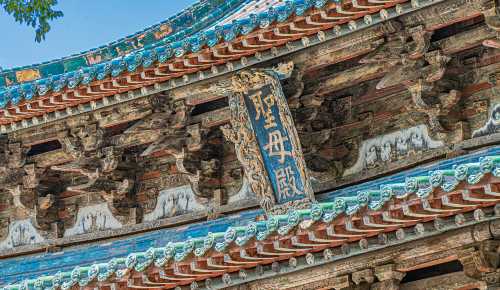Popular Trip Moments
The basic exhibition of Jin Ci Museum is now open to the public | Taiyuan's free-to-visit Weapons Exhibition Hall — North University of China Weapons Exhibition Hall | The most beautiful ginkgo season in Taiyuan! The 500-year-old ginkgo trees at Jin Temple have turned yellow | Adding a Jin Merchant Young Mistress in Taiyuan Ancient County Town | Stay at Home Inn Taiyuan Shuangta East Street, Encounter the Millennium Ancient Charm of Jin Temple | Taiyuan Confucian Temple | Dialogue with Confucius under the Millennium Lingxing Gate | Shanxi Taiyuan Five-Day Travel Guide | Cosmos Blossoming in Taiyuan Botanical Garden | The most beautiful season in Shanxi is about to arrive, with an attached autumn travel guide | Taiyuan Botanical Garden Kid-Friendly Guide: Popular Big Escalator + Baobab Tree | Three-Day Travel Guide for Changzhi | Jinzhong Three-Day Journey Through the Shanxi Merchants' Legacy | The beauty of autumn in Taiyuan is all hidden in these 7 secret spots! | Travel through Shanxi and have a dialogue with a thousand-year story | Shanxi Treasure Tour | One-Stop Check-in for Five Thousand Years of Civilization
Family, who understands! I went to Shanxi and felt like I traveled directly back to ancient times, immersing myself | Exploring Taiyuan Fohui Temple | Double Pagoda Park Must-Visit | Taiyuan-Xinzhou 2-Day Tour Popular Attractions Checklist | It's no surprise this Shanxi spot, checked in by 'Heavenly King's Wife' Hannah Quinlivan, is so breathtaking!
| Super satisfied with the seven-day Shanxi travel guide | Taiyuan Three-Day Travel Guide | Di Gong's Hometown Photo Guide | Luyashan Check-in Guide | Traveling in Taiyuan|Don’t just visit the ancient city! The village is great too! | Three Days to Explore Ancient Architecture in Shuozhou | Who says Yichuan only has Hukou? 2-Day In-Depth Tour: Mangtou Mountain Hiking Secret Spot Pitfall Avoidance Guide | National Day Self-Driving Tour - Evening of October 3rd at Taiyuan Botanical Garden | Autumn Deity Route Checklist! 2025 Off-the-Beaten-Path Secret Spots + Photo Tips | The Yongzuo Temple Twin Pagodas in Taiyuan
Recommended Attractions at Popular Destinations
Popular Attractions in Bangkok | Popular Attractions in Kuala Lumpur | Popular Attractions in Dubai | Popular Attractions in Chefchaouene | Popular Attractions in Kyoto | Popular Attractions in Los Angeles | Popular Attractions in Bali | Popular Attractions in Shanghai | Popular Attractions in Iguazu National Park(Argentina) | Popular Attractions in New York | Popular Attractions in Paris | Popular Attractions in Walt Disney World Resort | Popular Attractions in Melbourne | Popular Attractions in London | Popular Attractions in Singapore | Popular Attractions in Beijing | Popular Attractions in Las Vegas | Popular Attractions in Rome | Popular Attractions in Zanzibar Island | Popular Attractions in Sydney | Popular Attractions in West Lake | Popular Attractions in Osaka | Popular Attractions in Tokyo | Popular Attractions in Phuket | Popular Attractions in Barcelona | Popular Attractions in Madrid | Popular Attractions in Chengdu | Popular Attractions in Florence | Popular Attractions in Istanbul | Popular Attractions in Jungfrau Region
Popular Restaurants in Taiyuan
LIN XAING ZHAI RESTAURANT | LiuWei Zhai (LiuXiang) | 山西潇河新城万达锦华酒店·北岸全日餐厅 | Qing He Yuan | SHANXI HOTEL·Restaurant | 杨记灌肠(食品街店) | Bingcui Restaurant | Shun liu'er | 清和元(五龙口街店) | XING HUA TANG | JIN YANG GU SHI | JIN WEI ER | THE FOOD GALLERY OF BINGZHOU | Laocu Restaurant | 太原面食店(解放路店) | Hao GangGang YangZaGe Dian (LiuXiang) | SHAN XI GUILD HALL | DI FU JIA YAN | JIN WEI COURT | YIN XIANG GE | LAO TAI YUAN KITCHEN | 鼓楼羊杂割(双塔西街店) | 山西潇河新城温德姆至尊酒店·晋原·中餐厅 | 火焰山 涮锅 烤肉一体式自助餐厅(柳巷贵都店) | CAI FENG LOU | 恒義诚·老鼠窟国营饭店(桥头街店) | Zhuoxi Hotel·Lan Yue Western Restaurant | 御·高级日料(湖滨店) | 金泽锦绣老北京新火锅(南内环店) | 伍贰赫兹·云上法餐厅(太原店)
Popular Ranked Lists
Top 50 Must-Visit Restaurants in Songyang | Popular Trending Attractions in Hexigten Banner | Top 10 Trending Attractions in Xiamen | Popular Premium Hotels in York | Top 10 Trending Attractions in Hangzhou | Popular Premium Hotels in Mito | Top 20 Trending Attractions in Xi'an | Top 20 Trending Attractions in Harbin | Popular Premium Hotels in Floriana | Popular Premium Hotels in Ibaraki Prefecture | Top 50 Must-Visit Restaurants in Ningbo | Popular Trending Attractions in Luanchuan | Top 50 Must-Visit Restaurants in Vancouver | Top 10 Trending Attractions in Kyoto | Popular Trending Attractions in London | Top 20 Must-Visit Restaurants in Hefei | Popular Trending Attractions in Dunhuang | Popular Premium Hotels in Sagres | Top 50 Must-Visit Restaurants in Yangzhou | Popular Premium Hotels in Windermere | Popular Trending Attractions in Los Angeles | Top 50 Luxury Hotels near Mito | Top 10 Luxury Hotels near Tomigusuku | Popular Premium Hotels in La Guaira State | Popular Premium Hotels in Altea | Popular Premium Hotels in Sighnaghi | Top 50 Must-Visit Restaurants in Santorini | Top 20 Trending Attractions in Chongqing | Top 50 Must-Visit Restaurants in New York | Popular Trending Attractions in Lianyungang
About
Payment methods
Our partners
Copyright © 2025 Trip.com Travel Singapore Pte. Ltd. All rights reserved
Site Operator: Trip.com Travel Singapore Pte. Ltd.
Site Operator: Trip.com Travel Singapore Pte. Ltd.

















